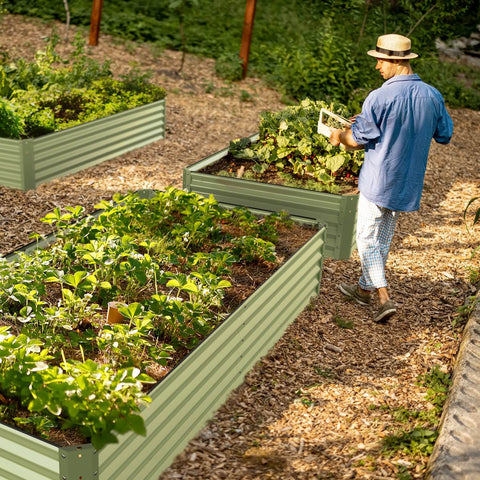Growing broccoli in a raised garden bed can be a rewarding experience, as it is a hardy vegetable that produces a bountiful harvest. In this blog post, we will go over the basics of growing broccoli in a raised bed, including the best varieties to plant, when to plant, soil preparation, and ongoing care and maintenance.

First, let's talk about the best varieties of broccoli to plant in a raised bed. Some popular varieties include:
-Calabrese: This is the most common type of broccoli and is known for its large, central head.
-Purple Sprouting: This variety produces smaller heads but has a longer harvest season.
-Romanesco: A unique variety that has a spiral-shaped head and a nutty flavor.
When to Plant
Broccoli is a cool-season crop, so it is best to plant it in the spring or fall. The ideal temperature for germinating broccoli seed is between 60 and 65 degrees Fahrenheit, so wait to plant until the soil temperature reaches that range. Spring-planted broccoli should be sown 4 to 6 weeks before the last spring frost date, while fall-planted broccoli should be sown 6 to 8 weeks before the first fall frost date.
Soil Preparation
Broccoli prefers a well-drained, nutrient-rich soil with a pH between 6.0 and 7.0. If your raised bed soil is heavy or clay-like, you should consider mixing in some organic matter, such as compost or aged manure, to improve the texture. In addition, you should also add a slow-release fertilizer to the soil before planting.

Ongoing Care and Maintenance
-Watering: Once your broccoli plants are established, they will need about 1 inch of water per week, either from rainfall or irrigation. Water at the base of the plants to avoid wetting the foliage, which can lead to fungal diseases. -Mulching: To help retain moisture and control weeds, you can add a 2-inch layer of mulch around your broccoli plants. Good options for mulch include straw, leaves, or grass clippings.
-Fertilizing: You can add additional fertilizer to the soil to keep the plants growing vigorously, with extra nitrogen to help promote leaf growth. You could also use a balanced fertilizer and spread it on soil surface or mix it into the soil, couple of inches away from base of the stem.
-Harvesting: The central head of the broccoli is the most desirable part of the plant, and it should be harvested when it is tight and firm, before the florets start to separate. Once the central head is harvested, side shoots will form and can be harvested for several weeks after the main head is harvested.
-Pest and Disease Control: Keep an eye out for pests like aphids, caterpillars, and mites, which can all cause damage to your broccoli plants. To prevent diseases like powdery mildew, be sure to water at the base of the plants, avoid wetting the foliage, and space the plants far enough apart to ensure good air circulation.

In conclusion, Growing broccoli in a raised bed can be a fun and rewarding experience, as long as you take the time to prepare the soil, choose the right variety of broccoli, and provide proper care and maintenance throughout the growing season. With a little bit of effort, you'll be able to enjoy fresh, nutritious broccoli straight from your garden.









